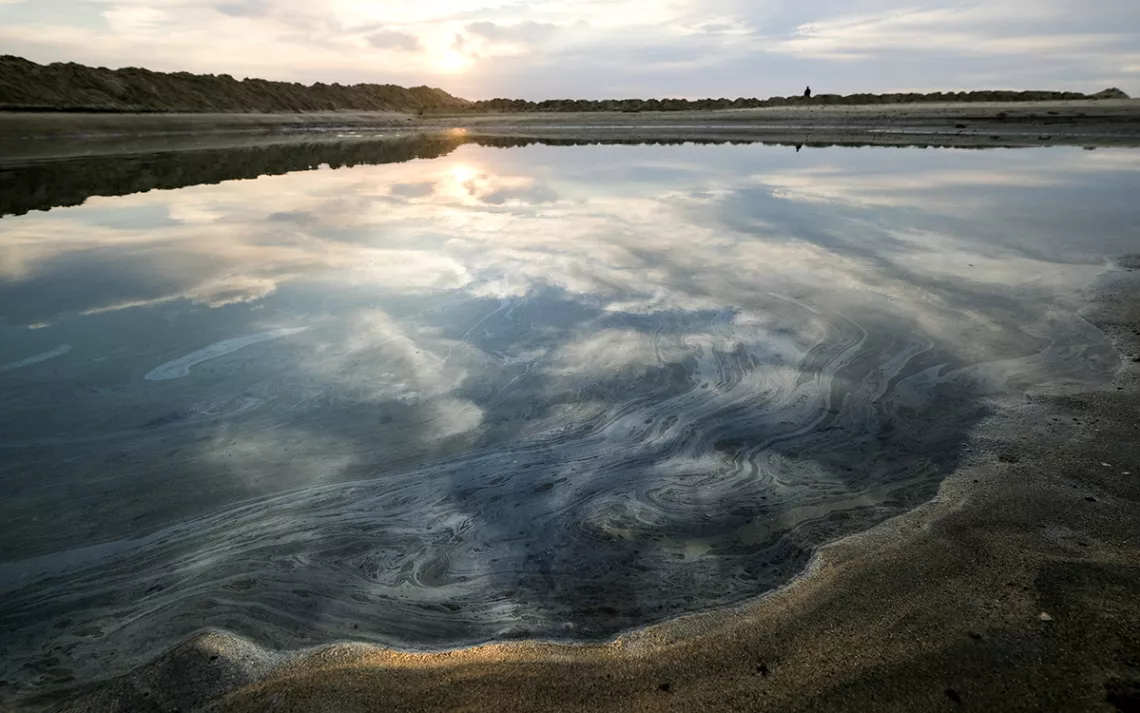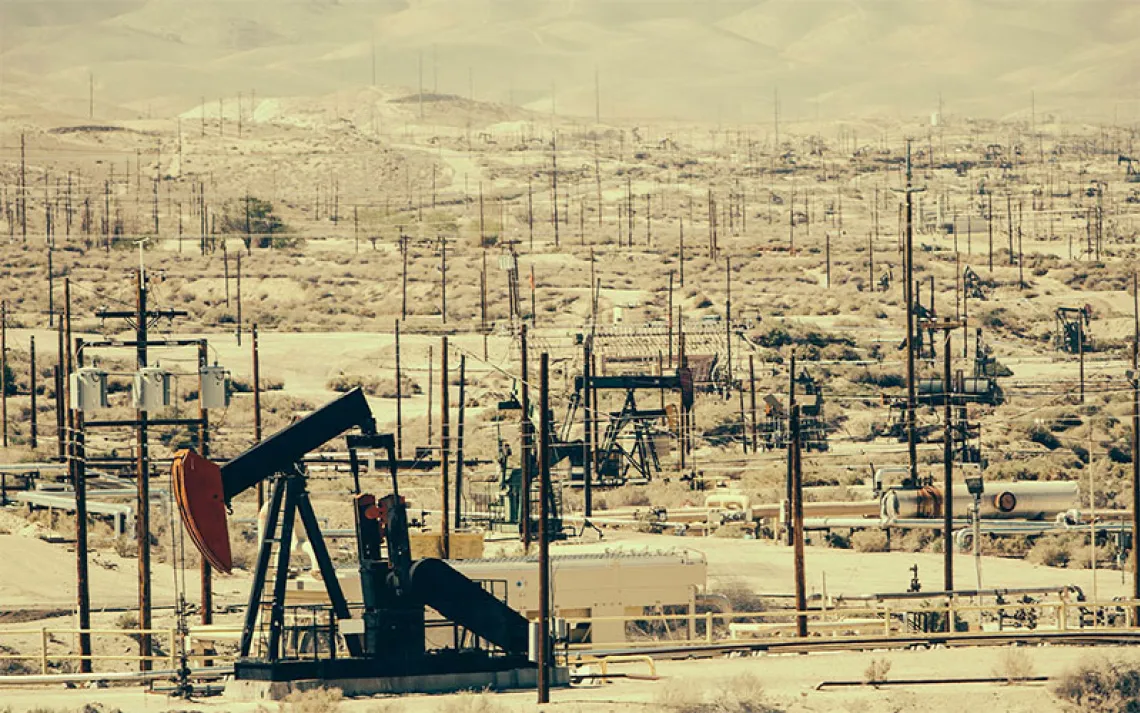Past Time to Shut Down Offshore Drilling
Aging infrastructure and a bottom-feeding oil company caused the Southern California spill, but only because we let them

Oil floats on the water surface after an oil spill in Hungtington Beach, California, on October 4, 2021. | Photo by AP Photo/Ringo H.W. Chiu
Saturday’s Huntington Beach oil spill, which emptied 144,000 gallons of crude into California’s life-filled Catalina Channel, was an ecological disaster that was at once a horrible shock and utterly predictable. The pipeline had been operating for longer than 40 years, delivering oil 17.3 miles from platform Elly in the offshore Beta field to refineries in the city of Long Beach. In 2012, its owner, Memorial Production Partners, acquired roughly half the Beta field for $271 million from Rise Energy Partners. Five years later, Memorial filed for Chapter 11 bankruptcy; after financial restructuring, it emerged as Amplify Energy and went to work again, checkered past and all.
This is not uncommon. Just before its pipeline burst on the picturesque coast of Huntington Beach, California, Amplify’s stock was on the way up. The company specializes in the acquisition and exploitation of what it calls “mature” oil and gas fields—fields with no future beyond short-term profits. It’s a booming business. As hydrocarbon wells age and their product becomes more difficult to extract, the big energy companies, maximized for efficiency, lose interest. So they sell to companies like Amplify, small companies with low overhead, whose modus operandi is to go in and get out with as much profit as possible.
There are dozens of such companies around the world. Some operate in California, where oil is drying up and was never easy to extract anyway because it’s too thick and heavy. Most favor less-regulated states, from Texas to Louisiana to West Virginia. These companies don’t need to suss out a field’s potential or drill wells; all they need to do, as a company called Power Drive puts it in its marketing literature, is “efficiently drain remaining hydrocarbons in any one area.” Some employ enhanced drilling techniques such as fracking or steam injection; others use carbon dioxide from carbon-capture projects to bring up the stuck oil. All of it is dangerous.
In the present case, Amplify’s own divers suggest the pipeline was caught and dragged by a ship’s anchor that was dropped in the wrong spot. (The US Coast Guard is investigating.) But it’s not a stretch to imagine the pipeline wasn’t particularly well cared for. In a sputtering industry suffering from depressed prices and pandemic-related losses, hardly anything is.
Neglect has been the cause of many past accidents. In 1997, 42,000 gallons of oil poured from Platform Irene off the coast of northern Santa Barbara County; three years earlier, Torch Operating Company had taken over the platform in 1994 from Unocal. At that time, Greg Helms, then spokesperson for the Santa Barbara–based Environmental Defense Center, told the Ventura County Star that the spill was "the latest in a fairly long and troubling history involving spills from our aging oil infrastructure off Southern California.” That was nearly 25 years ago.
A 2015 spill near Santa Barbara that slicked Refugio State Beach and surrounding waters with 142,000 gallons of oil was traced to a corroded underwater pipeline owned by Plains All-American Pipeline, which was found criminally liable and fined $1.5 million. Nearly $1 billion in settlements were leveled against Venoco Oil, which operated the drilling site and went bankrupt in the aftermath.
We won’t see the end of that troubling history soon. All up and down the California coast lies the wreckage of an industry that drilled, profited, and left a wake of leaky wells and rusty pipes, the legacy of an industry built around short-term profit. “If you look at the environmental documents for these ancient platforms, you see that the expected life span for them is 35 years,” says Miyoko Sakashita, oceans programs director at the Center for Biological Diversity. “They’ve already gone beyond that.”
In 2018, Sakashita toured California’s offshore oil network with Greenpeace and Earthworks and witnessed methane being flared from rusted platforms. “What we’ve got in the ocean,” she says, “is a ticking time bomb of decrepit infrastructure.”
The continued operation of that infrastructure is utterly at odds with California’s aggressive clean-energy ambitions. New leases for drilling in state waters within three miles from shore were prohibited in the aftermath of the 1969 oil spill off the Santa Barbara coast, which dumped 3 million gallons of crude into coastal waters and killed thousands of birds and other marine creatures. More recently, the state has fought drilling in federal waters by prohibiting new pipeline infrastructure onshore, and several platforms have recently been decommissioned.
But oil companies continue to drill new wells and rework old ones within their existing leases. “The operations that are still out there, persisting at a trickle, are still having a major climate impact,” Sakashita says. “The state should be moving rapidly to move them offline.”
This phenomenon is not unique to California. Crude oozes from aging pipelines on land and offshore in the Gulf Coast, the Great Lakes, and Eastern Seaboard. “We are so far behind in the US on how to manage our aging infrastructure,” Sakashita says. “Communities are being devastated by things like this all over the country.”
In Michigan, environmentalists lobbying to shut down Enbridge’s Line 5 have been told by the Canadian government that according to a 1977 treaty, the pipeline has to stay open until it fails. Line 3 in Minnesota is “a leaky mess,” says Beth Wallace, Great Lakes freshwater campaigns manager with the National Wildlife Federation. “But instead of retiring it, they’ve decided to rebuild that pipeline and make it even larger.” There are, she says, “no mechanisms in place to make it obsolete.”

Make every day an Earth Day
Get articles like this one sent directly to your inbox.
With this action you affirm you want to receive Sierra Club communications and may vote on policy designated by the Sierra Club Board.
Both pipelines are owned and operated by Enbridge Energy Partners. In 2010, oil from a pipeline in the city of Mounds View, Minnesota, caught fire and sent up a fireball that killed a mother and daughter. According to testimony at the time from the late Minnesota representative Jim Oberstar, “Enbridge had requested a two and a half year extension from the Department of Transportation’s Pipeline and Hazmat office to repair 329 defects on that line that they had known about for two years. Ten days later, the pipeline burst.”
The catastrophe in California comes just as ExxonMobil is looking for ways to restart three drilling platforms off the California coast. The pipelines it would have preferred will be shutting down, along with the local refinery, in 2023, so Exxon is proposing to truck the oil to refineries over state highways. Santa Barbara County officials and a coalition of environmental groups have been fighting the trucking plan, but Exxon argues that without a pipeline, trucks are the only option.
NWF’s Wallace says that now is the time for states to take a much more proactive role in pipeline safety. “On pipeline safety, the federal government is underfunded and understaffed,” she says, and current federal regulation consists mostly of self-reporting. The agency that regulates pipelines, the Pipeline and Hazardous Materials Safety Administration, is required to consider costs and benefits when it hands down regulations. If the Amplify pipeline didn’t have an automatic shutoff valve or leak-detection system, that’s why, says Bill Caram, executive director of the Pipeline Safety Trust in Bellingham, Washington. For the public, one accident is one too many. For the pipeline operator, a leak now and then, compared with the overall value of the product the pipeline moves, might be worth the risk. “We need to be passing much more stringent laws," concludes Wallace. "We need to focus on how we’re transitioning away from fossil fuels so things like this do not happen.”
“The transition away from oil and toward a clean-energy economy is inevitable,” says the Sierra Club’s senior associate director in California, Monica Mariko Embrey, in an emailed statement. “Requiring oil companies to clean up their old infrastructure can create good jobs for displaced oil workers to apply the skills and know-how they already have.”
Meanwhile, Amplify’s stock dropped 50 percent on the Monday after the spill. Despite federal laws holding the company responsible, that means it may not have the cash on hand to pay for cleanup and remediation of the waters and beaches it fouled. Taxpayers will.
 The Magazine of The Sierra Club
The Magazine of The Sierra Club



